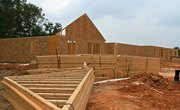
Modular construction is the process of building a home or other building in a factory in small pieces for assembly on-site. Though similar in some ways to the methods used for manufactured homes, modular homes can be in various shapes and sizes. Instead of just being in two halves like a double-wide, they're built to fit together like puzzle pieces.
Reduced Costs
One key advantage of modular construction is that it's more cost effective than traditional on-site building. Modular builders take advantage of economies of scale by building multiple similar pieces at once. They also get to work on smaller pieces of the building, reducing the need to use ladders or scaffolding. Finally, since the bulk of the construction and finishing work is done indoors, there's less risk of weather-related delays in construction that can cause workers to sit around idly waiting for the ability to work.
The Need for Speed
The nature of factory building also makes modular homes faster to build. They're frequently built on an assembly line that continuously operate. Companies have their own inspectors on site, so the units can be checked as they're built without having to wait for a city inspector to come and sign off on the work. Finally, when they get built on-site, all that needs to be done is to have them placed on the site and joined together. This process can be completed in hours or days instead of weeks or months.
New Construction
A modular home is a new home. This means that it's built to modern standards and comes with new appliances and systems. Since it's a newly built home, you also get to select your lot and, based on your community's laws and your builder's advice, site the house where you want it on your parcel. On the other hand, building a new home means that you need to find a lot and prepare it for building if it isn't already developed. You also can't move in when you close since you have to wait for the construction to finish.
Room Size
One of the drawbacks to a modular home is that, while the home can be very large, the room sizes are typically limited. The units in a modular home can't be too large to transport on roads, which means that they usually can't be more than 14 to 16 feet wide and 60 to 75 feet long. While the length usually isn't a limitation, the width is. On the other hand, modules can be 11 feet tall, which makes a 10 foot ceiling height possible if you desire. Stacking modules can give you a multi-story home as well.
Payment Plans
Modular homes typically need to be paid for up-front or financed on an as-you-go basis. In many cases, you won't be able to get a traditional bank loan until you finish the home. This means that you might have to take out a loan from your modular builder. Frequently, these loans carry higher interest rates than traditional mortgages. You will also need to find a way to finance the purchase of the site on which the house will be built.
References
- Modular Today: Pros and Cons of Buying a Modular Home
- Modular Today: Size Limits of Modular Home Construction
- U.S. News: 9 Reasons to Choose a New Home Over a Resale
- Sunshine Homes. "Modular Homes." Accessed Nov. 2, 2020.
- U.S. Department of Housing and Urban Development. "Manufactured Housing and Standards - Frequently Asked Questions." Accessed Nov. 2, 2020.
- Rocket Mortgage. "Modular Versus Manufactured: Which Home Is Right For You?" Accessed Nov. 2, 2020.
Writer Bio
Steve Lander has been a writer since 1996, with experience in the fields of financial services, real estate and technology. His work has appeared in trade publications such as the "Minnesota Real Estate Journal" and "Minnesota Multi-Housing Association Advocate." Lander holds a Bachelor of Arts in political science from Columbia University.

